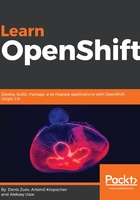
Conventions used
There are a number of text conventions used throughout this book.
CodeInText: Indicates code words in text, database table names, folder names, filenames, file extensions, pathnames, dummy URLs, user input, and Twitter handles. Here is an example: "Let's assume that the template is stored locally as wordpress.yaml."
A block of code is set as follows:
...
node('nodejs') {
stage('build') {
openshiftBuild(buildConfig: 'nodejs-mongodb-example', showBuildLogs: 'true')
}
When we wish to draw your attention to a particular part of a code block, the relevant lines or items are set in bold:
openshiftBuild(buildConfig: 'nodejs-mongodb-example', showBuildLogs: 'true')
}
stage('approval') {
input "Approve moving to deploy stage?"
}
stage('deploy') {
openshiftDeploy(deploymentConfig: 'nodejs-mongodb-example')
}
Any command-line input or output is written as follows:
$ vagrant ssh
Bold: Indicates a new term, an important word, or words that you see onscreen. For example, words in menus or dialog boxes appear in the text like this. Here is an example: "Once you click on the Log In button, the following page is displayed."